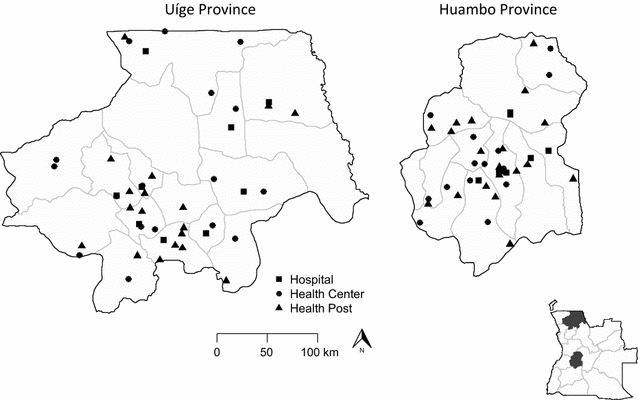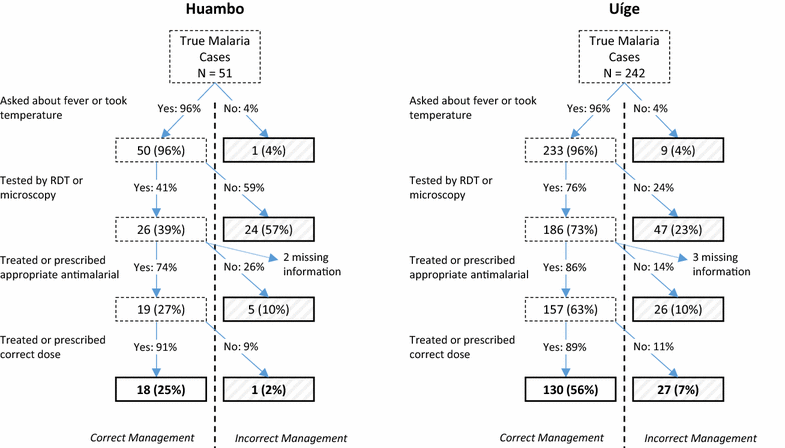Evaluating malaria case management at public health facilities in two provinces in Angola
- PMID: 28468663
- PMCID: PMC5415823
- DOI: 10.1186/s12936-017-1843-7
Evaluating malaria case management at public health facilities in two provinces in Angola
Abstract
Background: Malaria accounts for the largest portion of healthcare demand in Angola. A pillar of malaria control in Angola is the appropriate management of malaria illness, including testing of suspect cases with rapid diagnostic tests (RDTs) and treatment of confirmed cases with artemisinin-based combination therapy (ACT). Periodic systematic evaluations of malaria case management are recommended to measure health facility readiness and adherence to national case management guidelines.
Methods: Cross-sectional health facility surveys were performed in low-transmission Huambo and high-transmission Uíge Provinces in early 2016. In each province, 45 health facilities were randomly selected from among all public health facilities stratified by level of care. Survey teams performed inventories of malaria commodities and conducted exit interviews and re-examinations, including RDT testing, of a random selection of all patients completing outpatient consultations. Key health facility readiness and case management indicators were calculated adjusting for the cluster sampling design and utilization.
Results: Availability of RDTs or microscopy on the day of the survey was 71% (54-83) in Huambo and 85% (67-94) in Uíge. At least one unit dose pack of one formulation of an ACT (usually artemether-lumefantrine) was available in 83% (66-92) of health facilities in Huambo and 79% (61-90) of health facilities in Uíge. Testing rates of suspect malaria cases in Huambo were 30% (23-38) versus 69% (53-81) in Uíge. Overall, 28% (13-49) of patients with uncomplicated malaria, as determined during the re-examination, were appropriately treated with an ACT with the correct dose in Huambo, compared to 60% (42-75) in Uíge. Incorrect case management of suspect malaria cases was associated with lack of healthcare worker training in Huambo and ACT stock-outs in Uíge.
Conclusions: The results reveal important differences between provinces. Despite similar availability of testing and ACT, testing and treatment rates were lower in Huambo compared to Uíge. A majority of true malaria cases seeking care in health facilities in Huambo were not appropriately treated with anti-malarials, highlighting the importance of continued training and supervision of healthcare workers in malaria case management, particularly in areas with decreased malaria transmission.
Figures


Similar articles
-
Malaria Test, Treat and Track policy implementation in Angola: a retrospective study to assess the progress achieved after 4 years of programme implementation.Malar J. 2020 Jul 20;19(1):262. doi: 10.1186/s12936-020-03338-x. Malar J. 2020. PMID: 32690009 Free PMC article.
-
Quality of malaria case management at outpatient health facilities in Angola.Malar J. 2009 Dec 2;8:275. doi: 10.1186/1475-2875-8-275. Malar J. 2009. PMID: 19954537 Free PMC article.
-
Quality of malaria case management in Malawi: results from a nationally representative health facility survey.PLoS One. 2014 Feb 20;9(2):e89050. doi: 10.1371/journal.pone.0089050. eCollection 2014. PLoS One. 2014. PMID: 24586497 Free PMC article.
-
Private sector opportunities and threats to achieving malaria elimination in the Greater Mekong Subregion: results from malaria outlet surveys in Cambodia, the Lao PDR, Myanmar, and Thailand.Malar J. 2017 May 2;16(1):180. doi: 10.1186/s12936-017-1800-5. Malar J. 2017. PMID: 28464945 Free PMC article. Review.
-
Health workers readiness and practice in malaria case detection and appropriate treatment: a meta-analysis and meta-regression.Malar J. 2021 Oct 24;20(1):420. doi: 10.1186/s12936-021-03954-1. Malar J. 2021. PMID: 34689791 Free PMC article.
Cited by
-
Civil Engineering and Malaria Risk: A Descriptive Study in a Rural Area of Cubal, Angola.Trop Med Infect Dis. 2023 Feb 1;8(2):96. doi: 10.3390/tropicalmed8020096. Trop Med Infect Dis. 2023. PMID: 36828512 Free PMC article.
-
Performance of Antigen Concentration Thresholds for Attributing Fever to Malaria among Outpatients in Angola.J Clin Microbiol. 2019 Feb 27;57(3):e01901-18. doi: 10.1128/JCM.01901-18. Print 2019 Mar. J Clin Microbiol. 2019. PMID: 30626660 Free PMC article.
-
The quality of malaria case management in different transmission settings in Tanzania mainland, 2017-2018.PLOS Glob Public Health. 2023 Aug 21;3(8):e0002318. doi: 10.1371/journal.pgph.0002318. eCollection 2023. PLOS Glob Public Health. 2023. PMID: 37603541 Free PMC article.
-
Malaria Test, Treat and Track policy implementation in Angola: a retrospective study to assess the progress achieved after 4 years of programme implementation.Malar J. 2020 Jul 20;19(1):262. doi: 10.1186/s12936-020-03338-x. Malar J. 2020. PMID: 32690009 Free PMC article.
-
Malaria surveys using rapid diagnostic tests and validation of results using post hoc quantification of Plasmodium falciparum histidine-rich protein 2.Malar J. 2017 Nov 7;16(1):451. doi: 10.1186/s12936-017-2101-8. Malar J. 2017. PMID: 29115966 Free PMC article.
References
-
- National malaria control programme. National malaria strategy 2016–2020. Angola: Ministry of Health; 2015.
-
- Cosep Consultoria, Consaúde, ICF International. Angola Malaria Indicator Survey 2011. Calverton, Maryland: Cosep Consultoria, Consaúde, and ICF International 2011.
-
- Instituto Nacional de Estatistica. Angola: Standard DHS, 2015–16. 2016.
-
- Plucinski MM, Guilavogui T, Sidikiba S, Diakité N, Diakité S, Dioubaté M, et al. Effect of the Ebola-virus-disease epidemic on malaria case management in Guinea, 2014: a cross-sectional survey of health facilities. Lancet Infect Dis. 2015;15:1017–1023. doi: 10.1016/S1473-3099(15)00061-4. - DOI - PMC - PubMed
Publication types
MeSH terms
LinkOut - more resources
Full Text Sources
Other Literature Sources
Medical

